
Austrian postcard by Kellner-Fotokarten, Wien, no. 1038. Photo: Ringfilm. Jean Marais in Orphée/Orpheus (Jean Cocteau, 1950).
With his heroic physique, Jean Marais (1913-1998) was France’s answer to Errol Flynn, the epitome of the swashbuckling romantic hero of French cinema. The blonde and incredibly good-looking actor played over 100 roles in film and on television and was also known as a director, writer, painter and sculptor. His mentor was the legendary poet and director Jean Cocteau, who was also his lover.
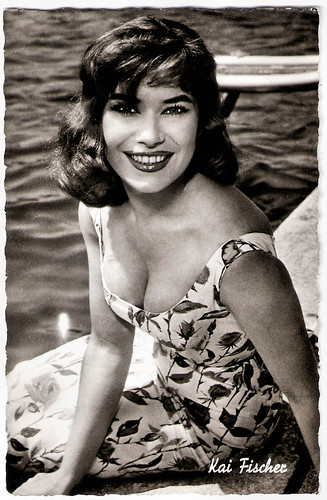
Austrian postcard by Kellner-Fotokarten, Wien, no. 287.
Red-haired and spirited German actress Kai Fischer (1934) appeared in 54 films between 1955 and 2004. She was the naughty bad girl of the Wirtschaftwunder cinema, and also appeared in sexy roles in international productions, either as a prostitute or a gangster girl. Later she worked with famous directors such as Wim Wenders and Ingmar Bergman.
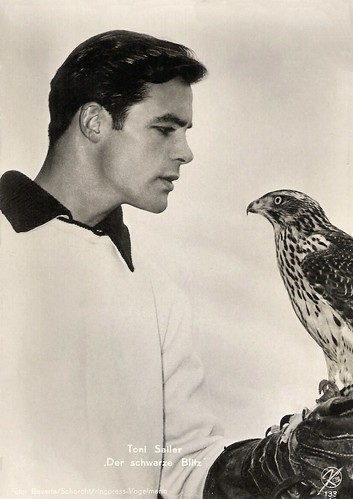
Austrian postcard by Kellner-Fotokarten, Wien, no. 1335. Photo: Bavaria / Schorcht / Ringpress / Vogelmann.
Toni Sailer (1935-2009) was a legendary Austrian alpine ski racer, one of the best the sport has ever produced. The ‘Black Blitz from Kitz’ appeared as an actor and singer in several films and TV series. He was a national hero and matinee idol rolled into one.

Austrian postcard by Kellner-Fotokarten, Wien, no. 1436. Photo: MGM. Mario Lanza in The Great Caruso (Richard Thorpe, 1951).
Mario Lanza (1921-1959) was an American tenor, actor and Hollywood film star of the late 1940s and the 1950s. His masterpiece was The Great Caruso (Richard Thorpe, 1951), the top-grossing film in the world in 1951. Lanza's voice was so dazzling that an awestruck Arturo Toscanini called it the "voice of the century".
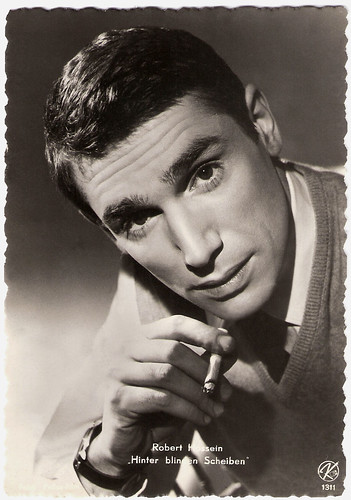
Austrian postcard by Kellner-Fotokarten, Wien, no. 1311. Photo: Robert Hossein in Méfiez-vous, fillettes!/Good Girls Beware! (Yves Allégret, 1957).
French film actor, director and writer Robert Hossein (1927-2020) was generally cast as a tough guy beside such gorgeous actresses as Brigitte Bardot, Sophia Loren and Marina Vlady. He is most famous though as Michèle Mercier's husband in the wildly popular Angélique series of the 1960s.
Heimatfilme
In the aftermath of World War II, Austria's film production soon restarted, partially supported by the Allied Forces.
Austria's cities were devastated and filmmakers set their works in the countryside to show the population the "good and beautiful" Austria.
The Heimatfilm genre came to life and remained popular from the late 1940s to the early 1960s. The films suggested a whole, romantic world untouched by war and the hazards of real life. More than three hundred Heimatfilme were produced in Germany, Austria and Switzerland during the 1950s.
Heimatfilme were usually shot in the Alps, the Black Forest, or the Lüneburg Heath, and always involved the outdoors. Their characteristics were their rural settings, sentimental tone and simplistic morality, and they centred on love, friendship, family and non-urban life.
They also involved the difference between old and young, tradition and progress, and rural and urban life. The typical plot structure involved both a good and bad guy wanting a girl, conflict ensuing, and the good guy ultimately triumphing to win the girl, making all (except the bad guy) happy.

Austrian postcard by Kellner, no. 958. Photo: Neue Terra. Carlos Thompson in Zwischen Zeit und Ewigkeit/Between Time and Eternity (Arthur Maria Rabenalt, 1956).
Handsome Carlos Thompson (1923-1990) was an Argentinian heartthrob of German-Swiss parentage. He started his career in Argentina playing leading roles on stage and in films. In the 1950s, he went to Hollywood and was typically cast as a European womaniser opposite such stars as Lana Turner and Yvonne De Carlo. He moved to Europe and appeared in a large number of German-language films. In the late 1960s, Thompson left acting to become a writer and TV producer.

Austrian postcard by Kellner-Fotokarten, Wien, no. 1075 Ö. Photo: Rank Organisation. Michael Craig in House of Secrets (Guy Green, 1956).
British actor Michael Craig (1928) is known for his work in theatre, film and television both in the United Kingdom and Australia. He also worked as a scriptwriter, such as for The Angry Silence (1960). In Italy, Luchino Visconti directed him in Vaghe stelle dell'Orsa.../Sandra (1965).
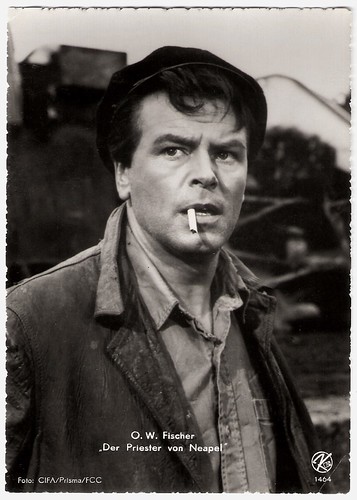
Austrian postcard by Kellner-Fotokarten, Wien, no. 1464. Photo: CIFA / Prisma / FCC. O.W. Fischer in II bacio del sole/Don Vesuvio/The Kiss of the Sun (Siro Marcellini, 1958).
Austrian actor O.W. Fischer (1915–2004) was one of the most popular and highest-paid actors in German-language films in the 1950s. He played the lead in dozens of light romantic comedies and historical pieces. Unlike countrymen Curd Jürgens, Maria Schell and Romy Schneider, he never made it internationally.

Austrian postcard by Kellner-Fotokarten, Wien, no. 1544. Photo: CCC / Bavaria / Arthur Grimm. Folco Lulli in Polikuschka/Polikuska (Carmine Gallone, 1958).
Acclaimed Italian film actor Folco Lulli (1912–1970) appeared in 104 films between 1946 and 1970, mainly in strong character roles. He was very active in both Italian and French cinema. Now he is best known as one of the four nitro-glycerine truck drivers in Henri Georges Clouzot‘s classic nail-biter La Salaire de la Peur/The Wages of Fear (1953).
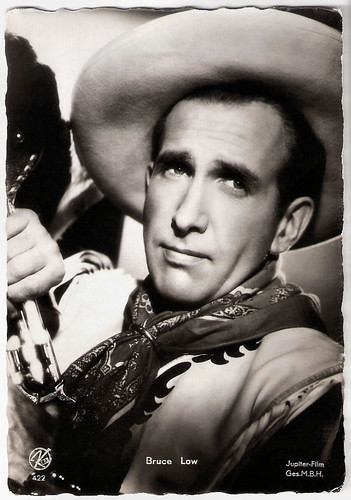
Austrian postcard by Kellner Postkarten, Wien (Vienna), no. 422. Photo: Jupiter-Film Ges.M.B.H. Bruce Low in Geld aus der Luft/Money from the air (Géza von Cziffra, 1954).
Bruce Low (1913-1990) was a Dutch Schlager and gospel singer and actor who had an impressive career in West Germany and Austria.
Imperial epics
During the age of the Wirtschaftswunder, there was little popular call in Austria for serious or critical films.
Veteran and new directors such as Ernst Marischka, Franz Antel, Geza von Cziffra, Geza von Bolvary and Walter Kolm-Veltee revised the comedy, provincial Heimatfilm, and biopic traditions, and began a new genre of the opulent imperial epic.
These imperial epics were set at the time of the Austro-Hungarian Empire as this period is identified with luxury, elegance, romance and a vision of Austria as large, powerful and peaceful. Extremely popular were Ernst Marischka's Sissi films starring Romy Schneider as Empress Elizabeth which found not only domestic but international success.
These films were the model for many other Austrian films of the period, such as Franz Antel's imperial-era musicals. The highly prolific Franz Antel became a household name with these films and with his popular comedies. These films rivalled Hollywood entertainment at the international box office.
Apart from Romy Schneider other Austrian film stars of the 1950s and rearly 1960s were Peter Alexander, Curd Jürgens, Hans Moser and ski champion Toni Sailer. The commercial Austrian film industry collapsed in the mid-1960s.

Austrian postcard by Kellner Fotokarten, Wien, no. 1030. Photo: Titanus / Union. Martine Carol in Difendo il mio amore/Defend My Love (Giulio Macchi, 1957).
Sex symbol Martine Carol (1920–1967) was one of the most beautiful women in French cinema. During the early 1950s, she was a top box office draw as an elegant blonde seductress. Her private life was filled with turmoil including a suicide attempt, drug abuse, a kidnapping, and mysterious death.
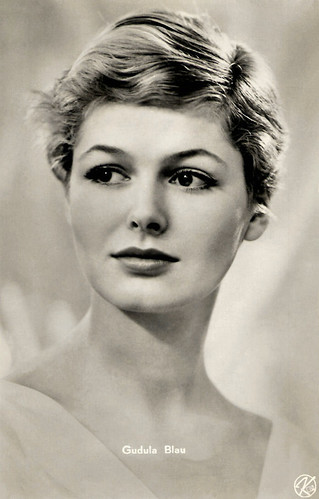
Austrian postcard by Kellner-Fotokarten, Wien, no. 81066.
Beautiful blonde Gudula Blau (1940) was a German actress who briefly appeared in German and Austrian entertainment films of the late 1950s. Later, she worked as an author, singer, and politician and incidentally played guest roles on television.
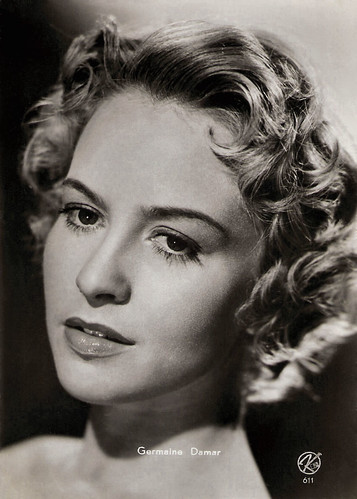
Austrian postcard by Kellner-Fotokarten, Wien, no. 611.
Luxembourg actress and dancer Germaine Damar (1929) started her career as an acrobat. She played in nearly 30 German films, including three films in which she was the partner of Peter Alexander.

Austrian postcard by Kellner Fotokarten, Wien, no. 81065. Photo: Paula Wessely Film / Hämmerer. Renate Holm in Wo die Lerche singt/Where the Lark Sings (Hans Wolff, 1956).
Renate Holm (1931-2022) is a German-Austrian film actress and operatic soprano. During the 1950s she was a popular star of Schlager films and operettas. In the 1960s, she became a star at the Vienna State Opera under the direction of Herbert von Karajan.
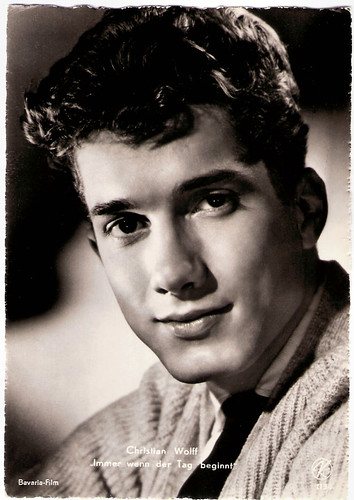
Austrian postcard by Kellner-Fotokarten, Wien, no. 81066. Photo: Bavaria-Film. Christian Wolff in Immer wenn der Tag beginnt/Always when the day starts (Wolfgang Liebeneiner, 1957).
Handsome Christian Wolff (1938) was a young lover of many German films of the late 1950s. He started out in the controversial 'gay' film Anders als Du und Ich/The Third Sex (1957) and later became a popular TV star in the long-running family series Forsthaus Falkenau (1989-2006).

Austrian postcard by Kellner-Fotokarte, Wien, no. 715. Photo: Vogelmann / Wessely-Film. Nicole Heesters in Liebe, die den Kopf verliert/Love that loses its head (Thomas Engel, 1956).
Austrian actress Nicole Heesters (1937) is the daughter of Dutch-born film star Johannes Heesters. With a rich film and stage career, she stepped out of the shadow of her famous father. As a film actress, she became known in the 1950s for such films as Dieses Lied bleibt bei Dir/Cabaret (Willi Forst, 1954). Later she played in dozens of TV films and series.

Austrian postcard by Kellner Fotokarten, Wien, no. 894. Photo: Columbia-Film. Bill Haley in Rock Around the Clock (Fred F. Sears, 1956).
Bill Haley & His Comets was an American rock and roll band that was founded in 1952 and continued until Haley's death in 1981. The band, also known by the names Bill Haley and the Comets and Bill Haley's Comets (and variations thereof), was the earliest group of white musicians to bring rock and roll to the attention of white America and the rest of the world.
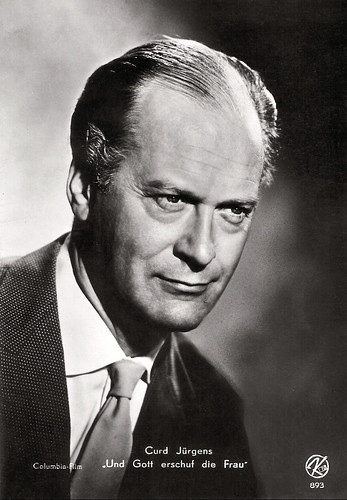
Austrian postcard by Kellner-Fotokarten, Wien (Vienna), no. 893. Photo: Columbia-Film. Curd Jürgens in Et Dieu... créa la femme/...And God Created Woman (Roger Vadim, 1956).
Tall, blonde, blue-eyed Curd Jürgens (1915-1982) played German soldiers in countless World War II films, usually billed as Curt Jurgens. Although the German-Austrian actor appeared in over 100 films, Jürgens considered himself primarily a stage actor. He also directed a few films with limited success and wrote screenplays.

Austrian postcard by Kellner-Fotokarten, Wien, no. 1394. Photo: Deutsche Cosmopol-film / Brünjes. Kai Fischer in Ich war ihm hörig/I Was All His (Wolfgang Becker, 1958).

Austrian postcard by Kellner-Fotokarten, Wien, no. 82090. Photo: Gloria-Film / Wesel. Eddie Constantine in Hoppla, jetzt kommt Eddie/Hi, Here's Eddie (Werner Klingler, 1958).
Craggy-faced Eddie Constantine (1917-1993) was an American actor and singer who spent his career as a tough guy in European films. He became famous for a series of French B movies in which he played private eye Lemmy Caution, based on the hero of the detective novels by Peter Cheyney.
Sources: Wikipedia and Infobelpro.
No comments:
Post a Comment